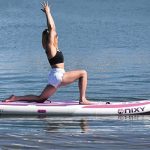Welcome to the ultimate guide to SUP yoga!
If you’re looking for a unique way to take your yoga practice to the next level, practicing yoga on a stand-up paddleboard (SUP) is an exhilarating and rewarding experience.
Not only does SUP yoga challenge your balance and core strength, but it also allows you to connect with nature and enjoy the tranquility of the water.
In this guide, we’ll walk you through everything you need to know about SUP yoga, from the best poses to try on your board to the different types of SUPs that are ideal for yoga.
Whether you’re a seasoned yogi or a beginner looking to try something new, we’ve got you covered. So grab your board, paddle, and yoga mat, and let’s dive in!
What is paddle board or sup Yoga?
Paddle board yoga is far greater than the components it consists of, however we can gain a fundamental comprehension of it by analyzing the two activities that were joined to create the fresh exercise.
SUP involves sitting, kneeling, lying down, or standing on a paddle board, and maneuvering with your arms or a paddle. Yoga involves a series of poses and stretches, in combination with mindful breathing, that can bring about advantages for the body, spirit, and mind.
Yoga while on a paddle board is what you get when you incorporate the poses while holding your balance on the moving board, which could mean you are sitting, kneeling, standing, or lying down.
What is the result when the two are blended together? You’ll receive a tremendous increase in advantages from both! The board bobbing up and down as it moves makes it more challenging for your muscles to stay in and hold each pose.
What Does SUP Yoga Mean?
Often, phrases such as “paddle boarding” and “stand up paddle boarding” are used to describe the same action, which involves standing on a board that is larger than a traditional surfboard.
Therefore, the words “SUP yoga” can be interpreted as Stand Up Paddle Board Yoga.
Why is Paddle Board Yoga Gaining in Popularity?
Stand-up paddleboarding has a lot of advantages, like burning calories and building muscle simultaneously. Furthermore, it provides your entire figure with a mild, non-jarring exercise, particularly being effectual in fortifying the stomach and back muscles at the core.
It is believed that taking part in SUP (stand-up paddle boarding), which occurs in an outdoor environment with water and fresh air, has both psychological advantages in terms of comforting and calming one’s mental state.
Take a look at our informative article, “Is Paddle Boarding Healthy?”, for a more detailed description of the health advantages associated with SUP.
The positive effects of yoga and paddle boarding are quite comparable. Exercising with yoga helps to build and tone your muscles, increases your coordination and balance, as well as heightening your posture.
Yoga helps mentally to free the mind of tension and focus it, resulting in more clarity of thought and the capacity to more readily handle life’s regular anxieties.
It is evident why SUP yoga has become a common part of many people’s healthy way of living when putting all of its advantages together.
Individuals who test out this idea are incredibly delighted with the outcome, to the point where they eagerly suggest that other people experience it for themselves (a play on words intended!).
The fact that you can do SUP yoga on a regular paddle board and that you can get specialized boards that help to optimize the outcomes of your yoga practice, is contributing to its growing popularity. We will investigate SUP yoga boards in greater detail shortly.
Paddle Board Yoga Poses
If you are just starting out with SUP yoga, it’s best to take it slow, even if you typically practice yoga or take part in paddleboarding. Maintaining your balance is key. Keep the board balanced by staying aligned with the handle, since this signifies the board’s center of gravity.
You can keep your equilibrium by fixing your eyes on the horizon or a spot on the land.
Here are 10 popular SUP yoga poses. Some poses will require more skill and experience than others, so you must become proficient at the simpler poses before progressing to the more complex ones.
It is essential to practice yoga with a qualified coach and to abstain from doing any postures you are either inexperienced with or not comfortable with.
Continue to practice your routines consistently – soon you will become proficient in all your positions!
1. Side Plank
Start off in the plank stance (facing the board with your hands and feet flat on the ground). Move your center of mass onto one side, turn your torso and lift your other arm from the surface. For this side plank variation, cross your legs with the bottom leg going in front of the top leg.
2. Crescent Lunge
Begin with the downward-facing dog pose and then move one foot in front of your hands. Angle the forward leg so that the knee is bent to a 90-degree angle, and the knee is centered directly above the heel.
Lift the heel of your back foot and place it directly over your toes. Bend the back leg at the knee and put the top of the foot on the floorboard. Lift your arms so that your hands are even with one another while arching your spine and gazing up.
3. Warrior Pose
Place your feet wide apart and point the right foot outward 90 degrees, angling the left foot inward. Extend your arms out to the side with the palms facing downward.
Rotate your right knee to a 90-degree angle and extend your foot forward past your toes. Turn your head to the right.
4. Three-legged Downward-Facing Dog
Change the downward-facing dog pose by extending one leg behind you and reaching it towards the sky. Make sure you keep your hip level with the board, so that it does not rotate.
5. Tree Pose on Left Leg
Position yourself upright with the right foot firmly positioned on the skateboard. Curve the left leg and place the left foot around the inside of the right leg. Once you sense a sense of equilibrium, greet someone with your hands placed together in the Namaste position at your chest.
Regain your balance and then lift your hands, which are still in the Namaste pose, up above your head.
6. Upward-Facing Dog
Assume the plank position. Bend your arms and lower your hips and legs to just above the floor. Maintain an extended posture with your arms and legs while curving your back and facing forward.
7. Headstand Lotus
It is essential to be proficient in the traditional headstand before attempting the difficult and stunning headstand lotus pose. From the classic headstand, you take one leg and put it on the other thigh, then do the same with the other leg.
8. Camel Pose
Squat down onto your heels and then raise your hips and butt forwards. Place your hands on the bottom of your feet while bending your back and looking up.
9. One-Legged King Pigeon: Left Foot Grab
You begin this pose in downward-facing dog position. Place the right foot ahead, balancing the right thigh and leg on the plank. Press your palms into the surface and arch your back gently, while bending your left leg.
Lift your arms and reach towards your left toes from the top. Retract the lower leg, curve your spine more and gaze straight ahead.
Replacing your yoga mat with a deck pad
You should check that the board’s extended-length deck pad does not have any ridges or bumps as they can be very uncomfortable for stand-up paddleboarding yoga. The best material that could be used for the deck pad is EVA foam because it has both durability and cushioning.
You should get a full length deck pad for your yoga SUP so it conceals the hard top of your designated yoga SUP. A deck pad usually measures the same size, or even larger, than a yoga mat.
A dedicated yoga board should have a robust bungee system
You should make sure the board is affixed with bungee cords so that you can use them to store your paddle and life jacket. There should be a specific area on the board where you can securely attach an anchor or attach it to another board.
Other things to look for in the best yoga SUPs
Apart from boasting an ample surface and a full-length sheet of foam, a premier yoga board should be both lightweight yet able to support a high weight limit. Take into consideration the fact that you may decide to have a pet or kids accompany you while you exercise yoga, so it would be better to have more weight-bearing capacity than underestimating it.
Many challenging yoga paddle boards have exhibited enhanced performance due to the ability to customize the front section of the yoga board to appear more like a displacement hull. It is not possible to do this activity with an inflatable paddle board.
Inflatable yoga boards
You don’t need a rigid board to enjoy the benefits of yoga. Using an inflatable board is an excellent choice for performing warrior poses. An inflatable stand-up paddle board usually has an identical quantity of deck area and a similar type of the span of deck cushioning as the rigid SUP.
If you don’t have much room to store it or you can’t carry it easily, an inflatable SUP might be a better choice than a board with a solid body. An inflatable Stand-Up Paddleboard could be preferable for certain SUP activities, such as white water paddle boarding.
The majority of the variations between a hard and inflatable stand-up paddle board are normally related to the heaviness and firmness of the paddle boards. Generally, an inflatable stand-up paddle board of superior quality is nearly as firm as a solid yoga board, with roughly 90 percent of the solid board’s stiffness.
The overall weight of inflatable yoga boards tends to be less than that of hard yoga boards.
The two types of SUP boards also have varying carry handles (or grab handles). The middle grip on a rigid SUP board is set down into the board, whereas the center handle on blow-up SUP boards is commonly a piece of fabric that is stitched onto the SUP board.
Benefits of Specialist SUP Yoga Boards
Yoga boards manufactured by Sup are engineered to provide the highest level of steadiness and safety while utilizing them. Broadly speaking, the width of these boards is usually 30 to 36 inches and they have more capacity than usual ones.
Some SUP yoga boards have a deck pad that is not as rigid as boards made from fiberglass, thus creating a softer and more relaxed position for the yogi.
The adhesion the platform provides is really significant to reduce the possibilities of you losing your balance when you start and finish your yoga poses. It is best if the front part of the skating board has a wider design since a few postures need more space for getting the feet and hands organized.
In downward dog, your hands should be spaced apart from one another.
why Consider an Inflatable Board for SUP Yoga
Traditional SUP boards can be difficult to carry or store and can be an overwhelming investment for novice users who may not realize the commitment required. Inflatable paddle boards , offer a great alternative. Here’s why:
Easy on the joints
Since they are filled with air, they provide more shock absorption for your joints when you’re on the go.
Offer a softer landing spot
If you make a mistake in a pose and manage not to plunge into the water, it is much more delightful to hit the forgiving surface of an inflatable stand up paddleboard than the harder surface of other boards.
Convertible and compact
iSUPs are so compact that they can be reduced to the same size as a sleeping bag and then be expanded into a full-sized paddle board when inflated. You can always bring your SUPs with you, without taking up too much space.
Whether you have a small car, decide to ride public transportation, or plan to take your SUP on your travels. The iSUP can be put away conveniently in a folded condition in any location.
Lightweight
No bulky biceps are needed in order to transport your inflatable stand-up paddleboard from the automobile to the shore.
Through the implementation of inflatable stand-up paddleboards, a greater number of individuals are now able to practice SUP yoga compared to if they had to use a heavier type of board.
Durability and rigidity
Yoga exercises done regularly will help you to avoid putting too much strain on your board. ISUPs typically consist of a tough PVC or epoxy material with a strong composite drop-stitch construction for increased stiffness.
Therefore, they can be flexible without being damaged, yet they will not slump in the center and absorb liquid.
in conclusion
Thank you for reading our guide to SUP Yoga! We hope you found it informative and useful in your journey to try out this exciting and adventurous form of yoga.
As you embark on your SUP Yoga practice, always remember to prioritize safety and to find a certified instructor who can guide you through the process. With the right preparation and mindset, you can experience the joys of practicing yoga on the tranquil waters, surrounded by the beauty of nature.
If you have any questions or comments, please feel free to reach out to us. And don’t forget to share this guide with your friends and family who might also be interested in trying out SUP Yoga.
Remember, the benefits of SUP Yoga extend beyond just physical fitness; it can also enhance your mental and emotional well-being. So, take the plunge and start your SUP Yoga journey today!




